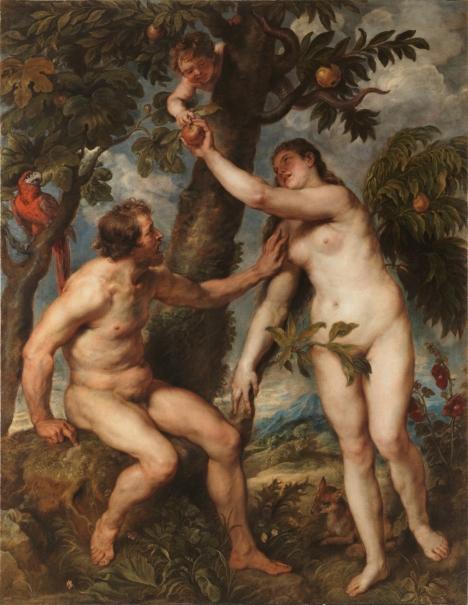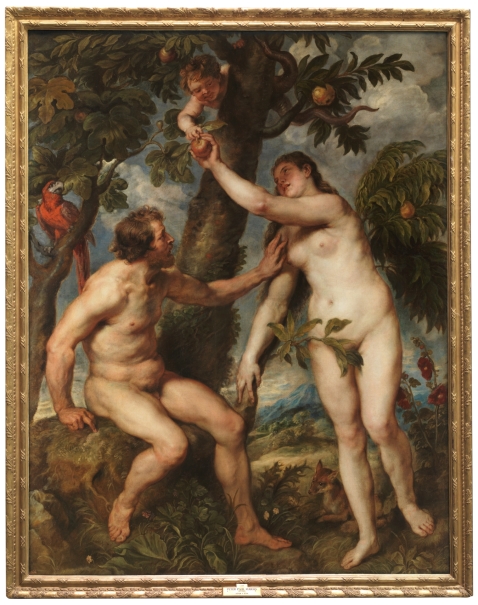Adam and Eve
Rubens, Peter Paul (Copy after: Titian (Tiziano Vecellio))
Rubens, Peter Paul (Copy after: Titian (Tiziano Vecellio))
Room 025
Eve accepts the forbidden fruit from the hands of the devil, who is half child and half serpent. Sitting on the roots of the tree of Good and Bad, Adam tries to stop her. This is a copy of a painting on the same subject that Titian made for Felipe II (P00429). Rubens saw it during his trip to Spain in 1628 and 1629. In keeping with his own concept of painting, he made significant changes with respect to the original, including the use of a more intense palette. He changed Adam´s position and gave him more muscles, basing his figure directly on the sculpture of the Belvedere Torso at the Vatican Museum. The inclusion of a parrot, not present in Titian´s work, as a symbol of Good, strengthens the idea of Redemption, which is contrasted with the fox that alludes to Evil and Lust. This work belonged to Rubens until his death, and appeared at the El Pardo Palace years later.
- See work in timeline
Tags
1628 1629 Painting Oil Canvas
RDF
RDF
Multimedia
See more multimedia content
Technical data
Related artworks
- Inventory number
- P001692
- Author
- Rubens, Peter Paul (Copy after: Titian (Tiziano Vecellio))
- Title
- Adam and Eve
- Date
- 1628 - 1629
- Technique
- Oil
- Support
- Canvas
- Dimension
- Height: 238 cm; Width: 184.5 cm
- Provenance
- Royal Collection (Palacio de El Pardo, Madrid, 1674, nº51; Palacio de El Pardo, Sala donde se abre para su majestad, 1701, nº51; Palacio de El Pardo, Pieza Vigesima nona, 1747, nº51 y 127; Palacio Nuevo, Madrid, Antecámara de S. M., 1772, nº51; Palacio Nuevo, Antecámara, 1794, nº10; Palacio Nuevo, Antecámara, 1814-1818, nº10; Museo Real de Pinturas a la muerte de Fernando VII, Madrid, Sala Reservada, 1834, nº63)
Bibliography +
Sánchez Cantón, Francisco Javier y Beroqui, Pedro, Inventarios Reales en 12 Volúmenes (Fotocopias), 1923.
Stechow, Wolfgang, Rubens and the Classical Tradition, Harvard University Press, Cambridge, 1968, pp. 41-45.
Fernández Bayton, Gloria, Inventarios reales: testamentaria del Rey Carlos II : 1701-1703 (procedencia/provenance), Museo del Prado. Patronato Nacional de Museos,, Madrid, 1975.
Díaz Padrón, Matías, Museo del Prado: catálogo de pintura: escuela flamenca, Museo del Prado. Patrimonio Nacional de Museos, Madrid, 1975, pp. 374-375.
Glang-Süberkrüb, Annegret, Einige Anmerkungen zu Tizians und Rubens Sündenfall, 1985.
V.V.A.A., Rubens: copista de Tiziano, Museo del Prado, Madrid, 1987.
Vosters, Simon A., Rubens y España: estudio artístico-literario sobre la estética del Barroco, Cátedra, Madrid, 1990, pp. 129-132.
Díaz Padrón, Matías, El siglo de Rubens en el Museo del Prado: Catálogo razonado, II, Prensa Iberica, Barcelona, 1996, pp. 992.
Anes, Gonzalo, Las colecciones reales y la fundación del Museo del Prado, Amigos del Museo del Prado, Madrid, 1996, pp. 202.
Goldfarb, Hilliard T., Titian and Rubens: power, politics and style, Isabella Stewart Gardner Museum, Boston, 1998.
Vergara, Alejandro, Rubens and his spanish patrons, Cambridge University Press, Cambridge, 1999, pp. 101.
Vergara, Alejandro, The Presence of Rubens in Spain, I-II, A Bell & Howell Company, Ann Arbor, 1999, pp. 372.
Portús Pérez, Javier, La sala reservada y el desnudo en el Museo del Prado, Museo Nacional del Prado. Turner, Madrid, 2002, pp. 112.
Aterido Fernández, A.; Martínez Cuesta, J.; Pérez Preciado, J. J., Colecciones de pinturas de Felipe V e Isabel Farnesio: inventarios reales, Fundación de Apoyo de la Historia del Arte Hispánico, Madrid, 2004.
Wood, Jeremy, Copies and Adaptations from Renaissance and Later Artist. Italian Masters II. Titian and North Italian Art, Corpus rubenianum XXVI (2), pt. II, V. I, Bruselas, 2010, pp. 111-119.
Vergara, A. Alba, L. Gayo, Mª.D, Rubens in Madrid (1628-1629): New technical evidence concerning his copies after Titian an a new portrait., Boletín del Museo del Prado., Tomo XXXI n.49, 2013, pp. 18-33.
García Cueto, David, La Colección Real española en los siglos XVI y XVII y el copiado pictórico: Una Aproximación contextual, Actas del Congreso internacional: Las copias de las obras maestras de la pintura en las colecciones de los Austrias y el Museo del Prado. Junio 2017, Madrid, 2021, pp. 8-16 [11].
Mazzarelli, Carla, 'Moltiplicare, tradurre, interpretare. Riflessioni in margine al ruolo delle copie tra prima età moderna e ricezione storiografica contemporánea' En:, Actas del Congreso internacional Las copias de obras maestras de la pintura en las colecciones de los Austrias y el Museo del Prado. Junio 2017, Madrid, 2021, pp. 17-25 [21 fg.3].
Other inventories +
Inv. Felipe IV, El Pardo, 1674. Núm. 51.
51 / Otro lienzo de Adan y Eva copia del Tiziano = don Antonio Baldeper deckarñi qye oarecñua cioua sacada de Rubenes
Inv. Testamentaría Carlos II, El Pardo, 1701-1703. Núm. 51.
Sala donde se abre para su Magestad [...] {76} Ottro Lienzo de Adan y Eba Copia de el tiziano con marco negro tassado en doze mill Reales de Vellon ... 12000 / Existe en la pieza 29ª. a los numeros 51 y 217.
Inv. Felipe V, El Pardo, 1747. Núm. 51 y 127.
Pieza Vigesima nona [...] 51 y 127 / Ôtro de tres varas de alto y dos de âncho que significa Adan y Eva
Inv. Carlos III, Palacio Nuevo, 1772. Núm. 51.
Antecamara de S. M. [...] 51 / Otro igual al antecedente [Adan y Eva en el Paraiso tomando las manzanas del arbol de Ticiano] copia del mismo de mano de Rubenes = Este se trujo del Pardo =
Inv. Testamentaría Carlos III, Palacio Nuevo, 1794. Núm. 10.
Antecámara [...] 10 / Otro [quadro] de la misma medida [tres varas de alto y dos y quarta de ancho] y asunto [Adan y Eva en el Paraiso] Copiado por Rubens ... 8000
Inv. Fernando VII, Palacio Nuevo, 1814-1818. Núm. 10.
Antecámara [...] 10 / igual [3 varas alto dos y quarta ancho] la copia de Rubens [de Adán y Eva de Ticiano]
Museo Real de Pinturas a la muerte de Fernando VII, 1834. Núm. 63.
SALA RESERVADA / Sesenta y tres. Adán y Eva. Copia del Ticiano que sacó para el Príncipe de Gales / Rubens. Flamenca / Lº / 80.600
Inv. Testamentaría Fernando VII, Real Museo, Sala Reservada, 1834. Núm. 63.
SALA RESERVADA. Sesenta y tres. Adán y Eva. Copia del Ticiano que sacó para el Príncipe de Gales Rubens. Flamenca Lº 80.600
Inv. Real Museo, 1857. Núm. 1666.
Rubens / 1666. Adan y Eva en el Paraiso Terrenal. / Copia del cuadro de Tiziano señalado con el num. 812 que hizo para el Príncipe de Gales. / Alto 8 pies, 6 pulg; Ancho 6 pies, 7 pulg.
Catálogo Museo del Prado, 1873-1907. Núm. 1613.
1613.-(1666-R.)- Adan y Eva, ó el pecado original.-Figuras de tamaño mayor que el natural.-Copia del cuadro de Tiziano número 456, con algunas pequeñas variantes en los accesorios. / Es tradicion que hizo Rubens esta copia para el Príncipe de Gales, Carlos Estuardo / Alto 2,37; ancho 1,84-L.
Inscriptions +
B.279
Inscribed with chalk. Stretcher
B279 [aparece dos veces]
Inscribed. Stretcher
G.E
Inscribed with chalk. Back
M.N.PRADO / 001692
On metallic tablet. Stretcher
Nº1692
Scrap of paper. Stretcher
1666.
Inscribed in orange. Front, lower left corner
Exhibitions +
Reunited
Madrid
06.06.2020 - 25.07.2021
Rubens
Madrid
05.11.2010 - 23.01.2011
Looking and Admiring. Rubens in Competition with Old Masters
Estocolmo
25.02.2010 - 23.05.2010
Looking and Admiring. Rubens in Competition with Old Masters
Munich
23.10.2009 - 03.02.2010
Valerio Castello (1624-1659). La música del Barroco
Génova
15.02.2008 - 15.06.2008
Location +
Room 025 (On Display)

Update date: 01-06-2024 | Registry created on 28-04-2015
Visor 360

Other works by Rubens, Peter Paul
Print on demand
Print artworks available in our catalogue in high quality and your preferred size and finish.
Image archive
Request artworks available in our catalogue in digital format.

























